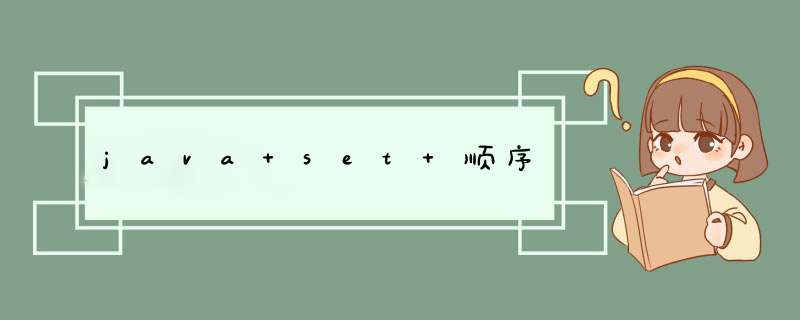
在java语言中,提供多种不同的结构来组织对象,Set(集合)是其中的一种,本身是一个接口,其迭代时的顺序取决于其具体实现。典型的实现包括:
HashSet:哈希表是通过使用称为散列法的机制来存储信息的,元素并没有以某种特定顺序来存放;
LinkedHashSet:以元素插入的顺序来维护集合的链接表,允许以插入的顺序在集合中迭代;
TreeSet:提供一个使用树结构存储Set接口的实现,对象以升序顺序存储,访问和遍历的时间很快。
扩展资料
Set<String>set = new TreeSet<String>()
set.add("f")
set.add("a")
set.add("b")
set.add("c")
set.add("d")
set.add("e")
System.out.println(set)
参考资料:百度百科 set (计算机学)
// 如果使用Set进行排序,那么必须要满足以下两个条件:// 1, 使用有序SET,即TreeSet
// 2, 被排序对象必须实现Comparable接口
// 这样做,其实是限制了排序的有效性(你可能不知道被排序对象是否实现了Comparable接口,而且你也不大可能要求程序中所有Model都实现这个接口)。
// 更好的排序方式是使用List进行排序,对List排序,只需要使用Collections.sort(list, comparator)静态方法。
// 第一个参数是要被排序的List,第二个参数是实现了Comparable接口的排序器。如果你要使用不同的排序方法,只需要替换第二个参数即可。
// 使用List进行排序,不需要被排序对象实现Comparable接口,而且排序算法是通过实现Comparable接口而来,这带来了极大的灵活性。
// 问题:我先将Set转为List,使用List排序后,再转为Set是否可行?
// 答案:基本不可行,如果将List转为无序Set,则不能保证顺序;若将List转为TreeSet,虽理论上说能保证顺序,但要求被排序对象实现Comparable接口。
// 可运行示例如下
import java.util.ArrayList
import java.util.Collections
import java.util.Comparator
import java.util.HashSet
import java.util.List
import java.util.Set
import java.util.TreeSet
public class Question {
class Person{
private int age
private String name
public String toString(){
return name + ":" + age
}
public int getAge(){
return age
}
public Person(String name, int age){
this.name=name
this.age = age
}
}
class PersonSortable extends Person implements Comparable<Person>{
public PersonSortable(String name, int age){
super(name, age)
}
@Override
public int compareTo(Person o) {
int thisAge = this.getAge()
int otherAge = o.getAge()
return thisAge - otherAge
}
}
class PersonComparator implements Comparator<Person>{
@Override
public int compare(Person o1, Person o2) {
int thisAge = o1.getAge()
int otherAge = o2.getAge()
return thisAge - otherAge
}
}
public Question(){
System.out.println("无序SET, Person未实现Comparable, 示例。")
try{
Set<Person>personSet = new HashSet<Person>()
personSet.add(new Person("John", 15))
personSet.add(new Person("Smith", 25))
personSet.add(new Person("Lee", 35))
personSet.add(new Person("Peter", 45))
personSet.add(new Person("Dick", 55))
System.out.println(personSet)
}catch(Exception e){
System.out.println("发生异常:" + e.getMessage())
}
System.out.println("有序SET,Person未实现Comparable, 示例。")
try{
Set<Person>personSet = new TreeSet<Person>()
personSet.add(new Person("John", 15))
personSet.add(new Person("Smith", 25))
personSet.add(new Person("Lee", 35))
personSet.add(new Person("Peter", 45))
personSet.add(new Person("Dick", 55))
System.out.println(personSet)
}catch(Exception e){
System.out.println("发生异常:" + e.getMessage())
}
System.out.println("无序SET, PersonSortable实现了Comparable, 示例。")
try{
Set<PersonSortable>personSet = new HashSet<PersonSortable>()
personSet.add(new PersonSortable("John", 15))
personSet.add(new PersonSortable("Smith", 25))
personSet.add(new PersonSortable("Lee", 35))
personSet.add(new PersonSortable("Peter", 45))
personSet.add(new PersonSortable("Dick", 55))
System.out.println(personSet)
}catch(Exception e){
System.out.println("发生异常:" + e.getMessage())
}
System.out.println("有序SET,PersonSortable实现了Comparable, 示例。")
try{
Set<PersonSortable>personSet = new TreeSet<PersonSortable>()
personSet.add(new PersonSortable("John", 15))
personSet.add(new PersonSortable("Smith", 25))
personSet.add(new PersonSortable("Lee", 35))
personSet.add(new PersonSortable("Peter", 45))
personSet.add(new PersonSortable("Dick", 55))
System.out.println(personSet)
}catch(Exception e){
System.out.println("发生异常:" + e.getMessage())
}
System.out.println("使用Collection.sort进行排序示例。")
try{
List<Person>personList = new ArrayList<Person>()
personList.add(new Person("John", 15))
personList.add(new PersonSortable("Smith", 25))
personList.add(new Person("Lee", 35))
personList.add(new PersonSortable("Peter", 45))
personList.add(new Person("Dick", 55))
Collections.sort(personList, new PersonComparator())
System.out.println(personList)
System.out.println("\t将排序后的结果封装回无序SET:")
Set<Person>personSetUnSortable = new HashSet<Person>()
for(Person person : personList){
personSetUnSortable.add(person)
}
System.out.println("\t" + personSetUnSortable)
System.out.println("\t将排序后的结果封装回有序SET:")
Set<Person>personSetSortable = new TreeSet<Person>()
for(Person person : personList){
personSetSortable.add(person)
}
System.out.println("\t" + personSetSortable)
}catch(Exception e){
System.out.println("发生异常:" + e.getMessage())
}
}
public static void main(String args[]){
new Question()
}
}
欢迎分享,转载请注明来源:内存溢出

 微信扫一扫
微信扫一扫
 支付宝扫一扫
支付宝扫一扫
评论列表(0条)